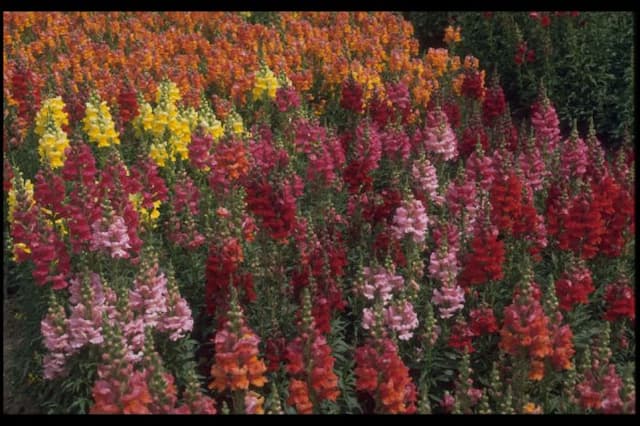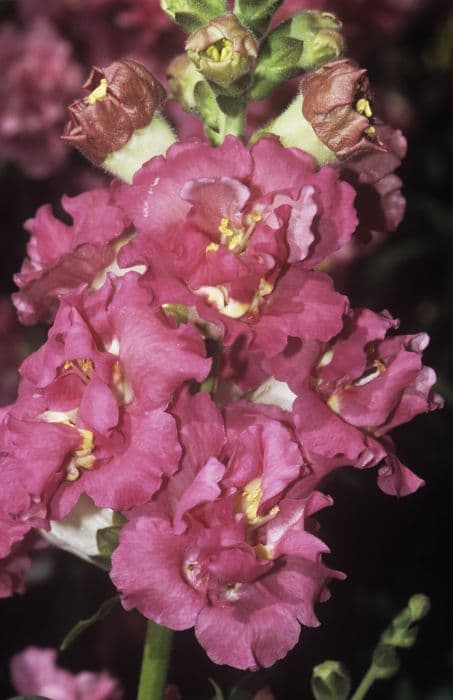Foothill Penstemon Penstemon heterophyllus 'Catherine de la Mare'

ABOUT
Penstemon heterophyllus 'Catherine de la Mare' is an attractive perennial known for its vibrant blue to violet flowers, which add a splash of color to gardens and landscapes. The blossoms are often tubular in shape, attracting pollinators such as bees and hummingbirds. The flowers are borne on erect stems that rise above the foliage, creating a striking visual display. The foliage of 'Catherine de la Mare' consists of narrow leaves that range in color from green to blue-green, providing a complementary backdrop to the bright flowers. The leaf arrangement is dense, giving the plant a lush, full appearance that adds texture and interest even when the plant is not in bloom. The leaves may sometimes take on a slightly different hue or intensity of color depending on the amount of sunlight the plant receives. Overall, the aesthetic of Penstemon heterophyllus 'Catherine de la Mare' is one of vivid, long-lasting bloom color set against verdant foliage. Its showy nature makes it a popular choice for gardeners looking to create a high-impact visual statement with seasonal flowering plants. The perennial's hardiness and ability to thrive in a variety of soil conditions contribute to its appeal as an easy-to-grow addition to any outdoor space.
About this plant
 Names
NamesFamily
Plantaginaceae
Synonyms
Foothill Penstemon, Blue Bedder Penstemon, Catherine de la Mare Penstemon
Common names
Penstemon heterophyllus 'Catherine de la Mare'.
 Toxicity
ToxicityTo humans
Foxtongue, the common name of Penstemon heterophyllus 'Catherine de la Mare', is not listed as a toxic plant to humans. There is no widespread or well-documented evidence of toxicity associated with this plant in humans. As with many plants, it is generally advisable not to ingest parts of plants that are not known to be edible, as they could cause digestive upset or allergic reaction in sensitive individuals.
To pets
Foxtongue, commonly referred to as Penstemon heterophyllus 'Catherine de la Mare', is not known to be toxic to pets. There is no significant evidence suggesting that this plant poses a risk of poisoning to dogs, cats, or other domestic animals when ingested. However, it is always best to prevent pets from eating plants not intended for consumption to avoid any potential gastrointestinal distress or allergic reactions.
 Characteristics
CharacteristicsLife cycle
Perennials
Foliage type
Evergreen
Color of leaves
Green
Flower color
Blue
Height
2 feet [60 cm]
Spread
2 feet [60 cm]
Plant type
Herb
Hardiness zones
7
Native area
California
Benefits
 General Benefits
General Benefits- Attracts pollinators - Penstemon heterophyllus 'Catherine de la Mare', commonly known as foothill penstemon, is attractive to bees, butterflies, and other beneficial insects, which are important for pollination.
- Drought-tolerant - Once established, foothill penstemon requires minimal water, making it an excellent choice for water-wise gardens and drought-prone areas.
- Easy maintenance - This plant is relatively low-maintenance, requiring little care beyond occasional pruning to promote bushiness and remove spent flower spikes.
- Long blooming period - Foothill penstemon has a long flowering season, often from late spring to early summer, providing extended color in the garden.
- Landscape versatility - With its vibrant blue to purple flowers, foothill penstemon can be used in a variety of landscape settings including borders, rock gardens, and native plant areas.
- Deer resistance - This plant is typically resistant to deer, making it an excellent choice for areas where deer browsing can be a problem for gardeners.
- Soil adaptability - Foothill penstemon can thrive in a variety of soil types, although it prefers well-drained soils, making it adaptable to many garden conditions.
 Medical Properties
Medical PropertiesThis plant is not used for medical purposes.
 Air-purifying Qualities
Air-purifying QualitiesThis plant is not specifically known for air purifying qualities.
 Other Uses
Other Uses- Foothill Penstemon can be used in artwork, such as pressed flower crafts, due to its vivid colors and interesting flower shapes.
- This plant's stalks can be used in dried floral arrangements, as they maintain their structure and color well after drying.
- Foothill Penstemon can be planted to stabilize soil in sloped gardens or erosion-prone areas due to its root system.
- It can be used as a natural dye for fabrics, yielding various shades of blue and purple depending on the mordant used.
- The flowers can be utilized in educational settings for botanical studies and pollination biology due to their distinct morphology attracting specific pollinators.
- Foothill Penstemon may serve as a companion plant in gardens to attract hummingbirds, which can also help with pollination of nearby plants.
- It can be used in sensory gardens, as the textured leaves and tubular flowers provide tactile and visual interest.
- The flowers can be incorporated into nature photography projects because of their striking appearance, especially in contrast with green foliage.
- This plant might be used in culinary presentations as an edible garnish, provided it has been grown organically and confirmed safe for consumption.
- Foothill Penstemon can also be used in permaculture designs as a perennial that fills the role of attracting beneficial insects to the garden.
Interesting Facts
 Feng Shui
Feng ShuiThe Foothill Penstemon is not used in Feng Shui practice.
 Zodiac Sign Compitability
Zodiac Sign CompitabilityThe Foothill Penstemon is not used in astrology practice.
 Plant Symbolism
Plant Symbolism- Resilience: Penstemon, also known as Beardtongue, often symbolizes resilience due to its ability to thrive in tough environments and poor soils.
- Diversity: The variety of Penstemon, including the 'Catherine de la Mare', represents diversity, as the species has a wide range of colors and adaptability to different habitats.
- Beauty: The striking blue to violet flowers of the 'Catherine de la Mare' illustrate the attribute of beauty, which is often a common symbol associated with ornamental plants.
- Attraction: Beardtongue can symbolize attraction, as its colorful blooms attract pollinators like bees and hummingbirds, essential for the ecosystem.
 Water
WaterFoothill penstemon should be watered deeply but infrequently to mimic natural conditions, ensuring well-drained soil to prevent root rot. During active growing seasons in spring and early summer, watering once every week or two, providing about one inch of water or approximately 0.623 gallons for an average-sized plant, is usually sufficient. Once established, they are drought-tolerant, and watering can be reduced. In cooler months or when rainfall is adequate, watering can be scaled back to once a month or less. Avoid overhead watering to prevent foliar diseases.
 Light
LightFoothill penstemon thrives in full sun to partial shade. It prefers at least six hours of direct sunlight each day, but in areas with hot summers, some afternoon shade can be beneficial. The ideal spot would be a south or west-facing location where the plant will receive ample light.
 Temperature
TemperatureFoothill penstemon is hardy and can withstand temperatures down to about 10°F, but ideally, they prosper in regions where the temperature ranges from 60°F to 85°F. These plants can survive up to temperatures of 90°F, but they will need extra care like mulching and adequate watering to cope with the heat.
 Pruning
PruningFoothill penstemon should be pruned to remove spent blooms and encourage a second flush of flowers. This pruning can be done immediately after the first flowering peak, usually in late spring or early summer. Deadheading, or cutting back by up to one-third in mid to late summer, can also help maintain a tidy appearance and promote plant health. Pruning is typically not required in the fall, as old stems provide winter interest and habitat for beneficial insects.
 Cleaning
CleaningAs needed
 Soil
SoilFoothill Penstemon thrives in well-draining, loamy to sandy soil with a slightly acidic to neutral pH of 6.0 to 7.5. A mix of two parts garden soil, one part sand, and one part compost or peat will ensure good drainage and fertility.
 Repotting
RepottingFoothill Penstemon typically doesn't require frequent repotting. It should be repotted every 2-3 years or when it outgrows its current container, using the same well-draining soil mix.
 Humidity & Misting
Humidity & MistingFoothill Penstemon prefers low to moderate humidity levels, consistent with its native dry, coastal, and foothill environments, making it adaptable to typical outdoor humidity conditions.
 Suitable locations
Suitable locationsIndoor
Place in bright light, minimal water.
Outdoor
Full sun, well-draining soil, hardy.
Hardiness zone
6-9 USDA
 Life cycle
Life cyclePenstemon heterophyllus 'Catherine de la Mare', commonly known as Foothill Penstemon, begins its life cycle as a seed, which upon germination in late winter or early spring, gives rise to a small seedling. The seedling establishes itself rapidly, developing a sturdy root system and foliage during its growth phase in spring. As temperatures warm in late spring to early summer, the plant enters its flowering stage, showcasing tubular blue to violet blooms which attract pollinators like bees and hummingbirds. After pollination, the flowers give way to seed capsules, and by late summer to fall, the plant sets seeds, completing its reproductive cycle. During fall and winter, Foothill Penstemon may become dormant, especially in colder climates, shedding its leaves and conserving energy in its roots. With the return of favorable conditions in the following spring, the plant will resume growth, repeating the cycle, with some individual plants living several years.
 Propogation
PropogationPropogation time
Spring-Summer
The most popular method for propagating the Penstemon heterophyllus 'Catherine de la Mare', commonly known as Foothill Penstemon, is by cuttings. This technique involves taking a 4 to 6 inch (approximately 10 to 15 cm) cutting from a healthy parent plant during the late spring or early summer. The bottom leaves are stripped off, and the cut end of the stem is dipped in a rooting hormone powder to encourage root development. The cutting is then inserted into a pot filled with a well-draining soil mix, ensuring that the node where the leaves were removed is buried. The soil should be kept moist but not wet, and the pot should be placed in a warm area with indirect sunlight until roots have developed, which can take several weeks. Once the cutting has established a strong root system, it can be transplanted into the garden.





![Snapdragon [Pretty in Pink]](/_next/image?url=https%3A%2F%2Fplants-admin.emdemapps.com%2Fimages%2Fplants%2F%2Fimages%2F604b5cb3b5385.png&w=640&q=75)



